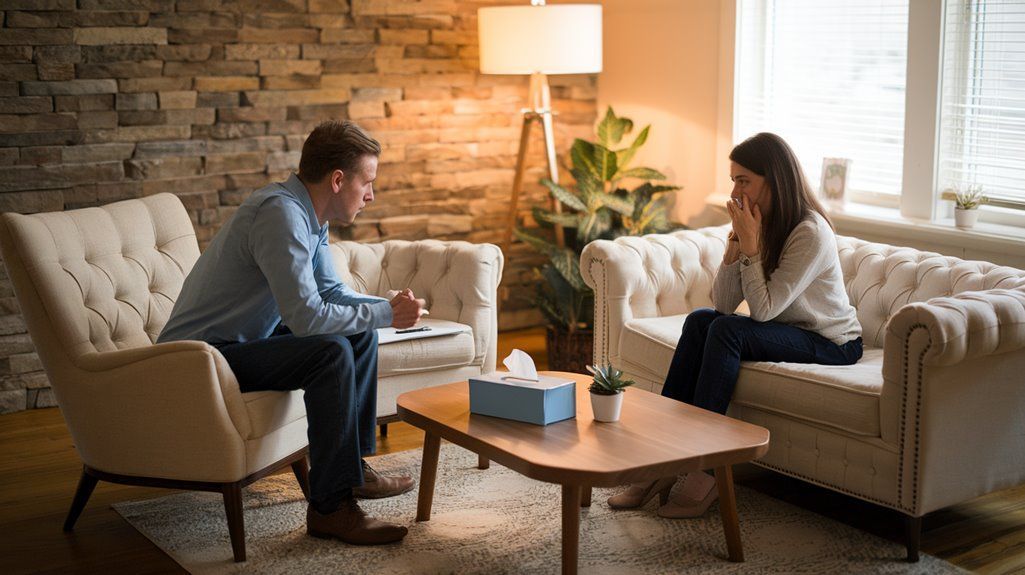Can Cognitive-Behavioral Therapy and Other Techniques Alleviate Anxiety Issues in Teens?
Share this article:

Cognitive-Behavioral Therapy (CBT) and other techniques can significantly help alleviate anxiety in teens. CBT focuses on identifying and challenging negative thought patterns, which is backed by research showing its effectiveness in reducing anxiety symptoms. Additionally, methods like mindfulness and relaxation techniques promote emotional regulation and calmness. Creative therapies, such as art therapy, offer unique emotional outlets, while peer support fosters a sense of belonging and validation. By combining these approaches, you can create a personalized strategy that meets your needs. If you explore further, you'll discover more strategies and insights to effectively manage anxiety.
Listen to the Article
Key Takeaways
- Cognitive-Behavioral Therapy (CBT) effectively reduces anxiety symptoms in teens by challenging negative thought patterns and promoting coping strategies.
- Additional methods like art therapy and mindfulness practices enhance emotional expression and reduce anxiety through creative and meditative outlets.
- Relaxation techniques, such as deep breathing and progressive muscle relaxation, can significantly decrease anxiety symptoms by promoting a sense of calm.
- Strong peer support networks provide validation and encouragement, helping teens share experiences and engage in healthy coping strategies.
- Combining various therapeutic approaches caters to individual needs, enhancing overall effectiveness in managing anxiety issues in adolescents.
Understanding Anxiety Disorders in Teens
During adolescence, many teens face the rising tide of anxiety disorders, which can manifest in various ways, from excessive worry about school performance to overwhelming social fears.
It's crucial to recognize that teen anxiety isn't just a phase; it's a legitimate mental health concern that can significantly impact daily life. Understanding anxiety symptoms is the first step toward helping those affected.
Common signs include persistent feelings of unease, irritability, and physical symptoms like headaches or stomachaches. You might notice a friend or loved one withdrawing from social situations, struggling to concentrate, or constantly seeking reassurance.
These behaviors can be distressing, not just for the individual but for those around them as well.
As someone who cares about helping others, it's essential to approach these situations with empathy and understanding. Encouraging open conversations about feelings can help destigmatize anxiety and promote healing.
Additionally, recognizing that anxiety disorders are treatable through various methods, including therapy and lifestyle changes, can empower you to support those in need.
Overview of Cognitive-Behavioral Therapy
Cognitive-Behavioral Therapy (CBT) is a highly effective approach that focuses on the connection between thoughts, feelings, and behaviors, providing teens with the tools they need to manage anxiety.
Through CBT, you help teens identify negative thought patterns that contribute to their anxiety. By challenging these thoughts, they can develop healthier perspectives, fostering greater teen resilience.
Empirical studies consistently demonstrate the therapy effectiveness of CBT in reducing anxiety symptoms in adolescents. This method empowers teens to recognize that their feelings are often influenced by their thoughts, enabling them to take control of their emotional responses.
As they learn practical coping strategies, they build a toolkit for navigating anxiety-inducing situations.
Additionally, CBT encourages teens to engage in gradual exposure to their fears, helping them confront challenges in a controlled manner. This process not only diminishes anxiety but also enhances their confidence in dealing with future stressors.
By fostering open communication and support, you can create a safe space for teens to explore their feelings and learn to cope effectively.
Ultimately, CBT equips teens with essential life skills, promoting long-term mental well-being and resilience in the face of anxiety.
Additional Therapy Methods
Anxiety management for teens often benefits from a diverse toolbox of therapy methods beyond Cognitive-Behavioral Therapy (CBT). One effective approach is art therapy, which allows teens to express their feelings creatively. Engaging in artistic activities can help them process emotions, reduce anxiety, and foster self-awareness.
Research shows that art therapy can be particularly beneficial for those who might struggle to articulate their thoughts verbally, providing a safe outlet for their feelings.
Mindfulness practices also play a crucial role in alleviating anxiety. Techniques such as deep breathing, meditation, and yoga encourage teens to focus on the present moment, reducing feelings of overwhelm.
Studies indicate that consistent mindfulness practice can lead to lower anxiety levels and improved emotional regulation.
Role of Relaxation Techniques
Often overlooked, relaxation techniques can significantly enhance anxiety management for teens. These strategies, such as deep breathing and progressive muscle relaxation, provide effective tools for calming the mind and body.
By practicing deep breathing, you can help your teen gain control over their physiological response to anxiety. Inhale deeply through the nose, hold for a moment, and exhale slowly through the mouth. This simple yet powerful technique encourages focus and promotes a sense of calm, making it easier to navigate stressful situations.
Progressive muscle relaxation complements deep breathing by guiding your teen through a process of tensing and relaxing each muscle group in the body. This method not only reduces physical tension but also increases awareness of bodily sensations, helping to disconnect from anxious thoughts.
Research shows that incorporating these techniques regularly can lead to a measurable decrease in anxiety symptoms.
Importance of Peer Support
While relaxation techniques can help calm the mind and body, peer support plays a vital role in managing anxiety for teens. Establishing strong peer connections creates supportive environments where you can share experiences and feelings, which is crucial for emotional well-being.
Studies show that teens who feel supported by their peers are more likely to develop resilience against anxiety.
Here are three key benefits of peer support:
- Validation: When you share your feelings with friends, it helps you realize that you're not alone in facing anxiety. This validation can significantly reduce feelings of isolation.
- Encouragement: Supportive peers can motivate you to engage in healthy coping strategies, like participating in group activities or practicing relaxation techniques together.
- Social Skills Development: Engaging with peers allows you to improve your social skills, which can help alleviate anxiety in social situations.
Medication Options for Treatment
When considering treatment options for anxiety, medication can be an effective part of a comprehensive approach. Different medication types, such as selective serotonin reuptake inhibitors (SSRIs) and benzodiazepines, can help manage symptoms. SSRIs are often the first line of treatment for teens, as they generally have a favorable safety profile and can improve mood and reduce anxiety over time.
Benzodiazepines, while effective for short-term relief, are typically not recommended for long-term use due to the risk of dependence.
Timing is crucial when it comes to medication. It might take several weeks to notice significant changes, so patience and consistent follow-up with a healthcare provider are key. Regular check-ins can help you assess effectiveness and adjust dosages if necessary.
It's important to remember that medication isn't a standalone solution. Combining it with therapies like cognitive-behavioral therapy (CBT) can enhance treatment outcomes.
Evaluating Long-Term Results
Medication can provide immediate relief for anxiety symptoms, but understanding the long-term results of treatment is vital for sustained emotional health. Evaluating these long-term outcomes helps you gauge therapy effectiveness, ensuring the methods used truly address your teen's needs.
Here are three key aspects to consider:
- Symptom Reduction: Research shows that cognitive-behavioral therapy (CBT) can lead to significant decreases in anxiety symptoms over time. Tracking these changes helps measure progress and adjust treatment as necessary.
- Coping Skills: Effective therapy equips your teen with tools to manage anxiety long after sessions end. Assessing how well they apply these skills in real-life situations can indicate therapy success.
- Quality of Life: Ultimately, the goal is to enhance overall well-being. Regularly check in with your teen about their feelings and daily experiences to evaluate whether therapy has positively impacted their life.
Frequently Asked Questions
How Can Parents Support Their Teens During Therapy?
To support your teen during therapy, practice active listening and offer emotional validation. Acknowledge their feelings without judgment. This creates a safe space, helping them feel understood and encouraging their willingness to engage in the therapeutic process.
What Signs Indicate Anxiety in Teens?
Picture a stormy sea; your teen may show signs of anxiety through behavioral symptoms like withdrawal or irritability, alongside emotional triggers such as sudden mood swings. Recognizing these can guide you in offering support.
Are There Specific Techniques for School-Related Anxiety?
For school-related anxiety, try mindfulness exercises to ground yourself and reduce stress. Exposure therapy can help you gradually face anxiety-provoking situations, building confidence over time. These techniques foster resilience and support your emotional well-being in school.
How Do Cultural Factors Influence Teen Anxiety?
Cultural factors shape the landscape of teen anxiety like a mosaic, where family dynamics and cultural stigma intertwine. Understanding these influences can help you support teens more effectively, fostering resilience and open dialogue in their lives.
Can Anxiety Lead to Other Mental Health Issues in Teens?
Anxiety can often lead to serious mental health consequences for you, including depression and substance abuse. It's crucial to recognize these risks early, fostering supportive environments that promote understanding and proactive intervention for teens facing anxiety.
Connect with Us:
Connect with Us:



